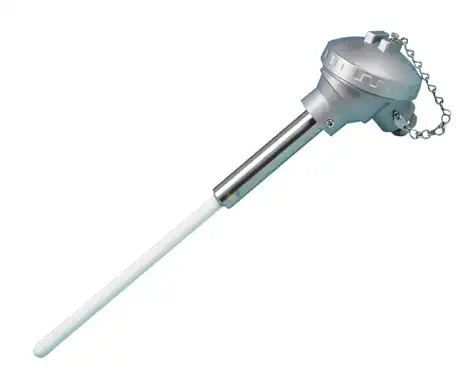Thermocouples, a remarkable interplay of thermoelectric principles, are ubiquitous in diverse industrial applications and scientific research. At their core, these devices translate changes in temperature into measurable electrical signals, fostering advancements in technology and enriching our understanding of heat transfer. By delving into the intricacies of thermocouples, one can not only appreciate their engineering brilliance but also comprehend their fundamental role in shaping modern thermal measurement techniques.
The genesis of a thermocouple lies in the intriguing phenomenon termed the thermoelectric effect, predominantly described by the Seebeck effect. This phenomenon occurs when two dissimilar metallic conductors, when joined at two junctions, generate a voltage differential proportionate to the temperature gradient established between the junctions. As this voltage is generated due to the movement of charge carriers within the metals in response to thermal energy, the conversion of thermal energy to electrical energy forms the bedrock of the thermocouple’s operation.
There exists a diverse array of thermocouple types, each tailored for specific temperature ranges and environments, predominantly denoted by letters of the alphabet. The most common types include Type J, K, T, and E. Type K thermocouples, for instance, are extensively utilized due to their broad operational range and excellent stability; they can accurately measure temperatures from -200°C to 1260°C. Such versatility renders them indispensable in numerous applications ranging from food processing to welding. Conversely, Type J thermocouples offer a slightly narrower range, primarily effective for applications below 750°C, yet excel in their sensitivity to rapid temperature changes.
Delving deeper into the operational efficacy of these instruments, one must consider the calibration and material composition of thermocouples. The calibration process optimizes the thermoelectric response and is pivotal for ensuring accuracy across the desired temperature range. Thus, certain thermocouples utilize noble metals, such as platinum and rhodium, in their construction to enhance stability and precision, particularly in high-temperature conditions. Such considerations are critical in industries where precision is paramount, such as aerospace, pharmaceuticals, and semiconductor manufacturing.
In addition to their fundamental operating principles, the impact of thermocouples extends into innovative realms, such as industrial automation and control systems. Many contemporary processes incorporate sophisticated feedback loops where thermocouple data informs control systems, enabling fine-tuning of processes to achieve optimal efficiency and safety. For example, in a kiln firing ceramics, real-time temperature monitoring via thermocouples can avert overheating, which can degrade product quality and create hazardous conditions. The integration of thermocouples into complex systems exemplifies their transformative potential in enhancing control and predictability across various fields.
Exploring the advantages of thermocouples reveals the layers of their superiority over alternative temperature-sensing technologies, such as resistance temperature detectors (RTDs) and thermistors. Thermocouples boast remarkable linearity over large temperature ranges, rapid response times, and greater durability, particularly in extreme environments, rendering them indispensable in sectors that require resilience and reliability. Furthermore, their simplicity and cost-effectiveness make them an attractive choice for projects with budgetary constraints or those requiring extensive deployment.
Nevertheless, with every advantageous facet, inherent limitations also merit consideration. Thermocouples, while adept at high temperatures, are susceptible to issues such as drift, particularly in prolonged exposure scenarios. Their accuracy can be compromised by electromagnetic interference, necessitating meticulous installation practices. Therefore, the selection of an appropriate thermocouple type for a specific application should be underpinned by a thorough understanding of these limitations.
As one contemplates the future trajectories of thermocouples, advancements in materials science and nanotechnology promise a new era of enhanced functionality. The exploration of novel materials may yield thermocouples with unprecedented accuracy and wider operational ranges, potentially enabling the detection of temperatures in extremes yet uncharted by conventional devices. Such innovations could revolutionize sectors like climate science, astrophysics, and materials engineering where temperature measurements are critical yet challenging.
Moreover, the integration of thermocouples into the Internet of Things (IoT) ecosystem is poised to transform how temperature data is collected and utilized. Wireless thermocouples linked to advanced data analytics platforms could enable remote monitoring and predictive analytics, enhancing decision-making in various industries. This evolution is not merely an enhancement but a paradigm shift that underscores the continuing relevance of thermocouples in the age of digital connectivity.
In summary, thermocouples encapsulate a rich tapestry of thermodynamic principles, engineering ingenuity, and material advancements. Their capacity to convert thermal energy into electrical potential has opened doors to understanding the physical world with greater precision and has facilitated the growth of technology across a multitude of disciplines. As our capabilities expand with innovative materials and digital integration, the exploration of thermocouples will continue to intensify, ensuring they remain paramount in both industrial applications and scientific exploration. The interplay of concepts within thermocouples invites a new realm of curiosity, urging ongoing inquiry into their potentials and applications. In a future driven by relentless innovation, the exploration of thermocouples beckons as both a beacon of knowledge and a harbinger of technological evolution.










